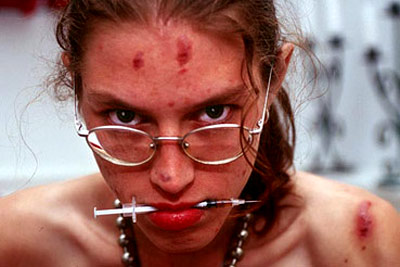
This article was first published in the New York Press.
HE WEARS A black hoodie to protect himself from the cold rain. The baby-faced guy is Dominican, probably in his early twenties. He rushes by me at the Graham Avenue L train entrance, pauses and asks, “Matt?” I nod. He leads me down the stairs, examines me silently. Once he’s satisfied that I’m not a threat, he takes $30 from my left hand and pushes a sealed bag of Cheez Doodles into my right jacket pocket. Without another word, he splits for the opposite staircase and races back above ground. I check my watch. It’s 6:30 on a Saturday night under a busy Williamsburg intersection, and I’ve just scored three bags of “Nike” heroin, all hidden inside a re-sealed bag of chips.
Nike is the highest quality brand of heroin going around Williamsburg, according to Rob (not his real name), a scruffy 27-year-old I know from my junkie past. Rob admits to sometimes using as much as 16 bags a day. He lives in an apartment near the Graham L stop filled with piles of empty glassine bags and orange syringe caps. The handoff, which Rob set up after a few minutes and a couple of texts while at his parents’ house in Connecticut, was the culmination of months of research that was spurred on by a spate of recent media reports claiming that America—and especially the New York metro area—is suffering from a terrifying new heroin epidemic. Curious, I decided to revisit a world that had once held me in its clutches for so long. This time around, I brought along a notebook and a clear head.
The Sunday, Oct. 3 cover of Newsday read “Heroin Hits Main Street.” Under slightly less-lurid headlines, several recent New York Times features have promoted similar concerns. A Sept. 27 Sunday Metro cover story, “Young and Suburban, and Falling for Heroin,” chronicled the rise of a new kind of young, middleclass addict, a development “especially worrisome” to Suffolk County authorities. Reporter Cara Buckley used the example of a 17-year-old girl from Suffolk County whose low self-esteem catapulted her from pot to skag to rehab.
Heroin, Buckley quoted a rehab doctor as saying, “is becoming cooler.” In a long sidebar the same writer reported that the heroin available in urban centers today is much purer, and therefore much more potent, than the street skag of 10 or even 20 years ago. Buckley quotes a prosecutor who claims that the purity level has increased from “less than 5 percent” in the heroin-blighted 1970s to “as high as 20 percent” now. In case readers don’t get the hint in the main article, the sidebar explicitly states that “younger, more educated people are getting hooked.” Taken together, the two pieces—reporting an uptick in middle-class demand and better quality supply—warn the typical Times reader: Hide your kids!
Not so fast. Haven’t we read this all before? Yes. In fact, 13 years ago, a Sept. 8, 1996, Times article outlined the same dual trend in a remarkably similar story headlined, “Heroin Moves In On a New Generation.” Back in the glory days of heroin chic, it was an anonymous girl from Connecticut who conveniently fleshed out the epidemic, which began: “She started taking drugs when she was 15.” The author of the 1996 piece cites a source to maintain, “While the supply is on the rise, so too is the purity of the heroin.” It’s as if the past 13 years never happened.
Actually, the Times’ latest wave of reporting on the rise of heroin use among young people began again back in a Jan. 13, 2008 article that asserted the phenomenon was nationwide but focused on the New York City metro area: “Experts say that more high-quality heroin is being put on the streets of the New York City suburbs than ever before, and at what are considered historically lower prices.” According to this story, suburban teens can now purchase heroin in amounts of “a 10-gram ‘deck,’ which can cost as little as $7 on the street.”
As anyone with experience with the drug will tell you, this is a laughably low figure. While it has fluctuated in quality, heroin in New York has fetched roughly the same price since the early 1980s: $10 for a bag containing 1/10 of a gram of powder, about the size of a line of coke. (Typically one bag will get someone without a habit stoned for a few hours.) In other words, the Times was off by a factor of 10. More recently, on May 29 of this year, the Gray Lady warned readers of “a powerful form of heroin” called “black tar” moving through the Mideastern hinterlands. Even straights in good standing, if they’ve read the Times long enough, can tell you that there is nothing new about black tar. On Sept. 13,1986, the paper’s Peter Kerr reported, “A powerful new type of heroin, black tar, has appeared” in Chicago and points west. Black tar is not pure; it is highly cut with sticky chemical additives—as legions of West Coast junkies can attest. A 36-year-old former addict who spent many years in San Francisco explained to me, “that shit is so nasty, it’s like syrup.” Revealing several scars from healed abscesses on his arm, he adds, “It just destroyed my veins.”
But should we be surprised? This sort of media-inflated dope hysteria dates back to the early 1950s when pulps with titles like The Pusher and Dope Doll included illustrations of cartoonish, middle-class fiends strung out by hustlers. The politically moderate urban sociologist Eric Schneider, in his comprehensive history of domestic heroin use, Smack: Heroin and the American City, argues forcefully that a fear of the suburbanization of an opiate epidemic, although dating back to Eisenhower-era anxieties, reached a fevered pitch in the post-hippie 1970s. Around every decade or so, the press uncovers something both ominous and familiar under the floorboards: white, affluent heroin users.
Given that heroin has existed for so long in the city, is it any wonder middle-class whites have long gotten their hands on the stuff? During periods of economic growth, they scrape by without causing trouble. In periods of economic decline, however, the consequences of hard drug use become more prevalent. The financial motivation to deal increases, coupled with an attempt to reach new clients. Prescription opiate painkillers, more expensive than heroin on the black market, and favored by most suburban users, can also become more difficult to obtain for many in bad times as well. In any event, as new users get in over their head, social ills such as shoplifting and overdoses begin to rise. That’s when junkies begin to be noticed and editors assign their heroin stories and reporters try to craft a nightmare scenario for a new generation.
It’s a sunny Friday morning, and a crew-cut white kid struts into a near-empty Tompkins Square Park. He impatiently asks two homeless crust punks rinsing their dreadlocks at the water fountain to please move. He fills a syringe with water and sits down on a nearby green wooden bench. Balancing the rig beside him, he guides a plastic cap and a small, square unstamped glassine bag of skag out of his striped shorts. He pours the bag’s contents into the cap, sprays water into it, shakes up the solution and draws it back up into the syringe through a cotton ball. Licking his lips while he brings the syringe to his forearm, he gets distracted as I eye him from the bench across the blacktop.
“You’re going to do that right in the open?” I ask. The young junkie answers by sticking the needle into his flesh and pushing the heroin into a vein. Smiling stupidly, he gathers his works and hurries off. Two minutes later, he’s back with a sullen look on his face and a bearded crust punk in tow. They are a mix-matched pair—one clean cut, the other filthy. Sitting down on the same bench after getting water from the fountain, they each unfurl works and prepare their shots. Emboldened by a partner, Crew Cut sardonically asks me, “Be our eyes?” After getting his second hit of the morning, Crew Cut looks more relaxed, his eyelids droop. He pockets his syringe and stands up. Under the wave of sedation, his knees buckle a bit and he nods off. Then he shakes himself awake and lopes away. Meanwhile, waiting to feel the dope’s flash, the bearded crust punk gazes straight ahead. Finally he says, “This shit I just copped isn’t very good.”
Nodding sympathetically, I ask the him a few questions.
His name is George, and he’s from northern New Jersey. At 28, he’s homeless and has been using H since he was 18, about the age his crew-cut pal is now. His body shows the results: jaundiced skin, yellowing eyes and a frail posture—symptomatic of hepatitis C—combine to make him look much older. Topped by a black Yankees cap, his yellow face—tattooed with small designs—is haunting. His eyes flash a wary knowledge of his own decrepitude. Despite his rough appearance, he’s friendly and eager to talk.
As his medical wristbands—which he wears while begging for money—prove, George has been hospitalized four times in the last two weeks for overdoses and seizures. Store managers will not let him use their bathrooms, so he gets off in the park. George ticks off his list of ailments: addiction, alcoholism, hepatitis C and pancreatitis. He claims to have two kids somewhere. Adding to George’s sordid fate, his wakeup bag didn’t even tighten him up. He’s been trying to get into a city detox so he can lower his tolerance, but he doesn’t have any I.D. “Basically, I’m fucked, I have a year to live,” he mutters. “Can you buy me a beer?” To people who only know Manhattan in its boom-era incarnation, the existence of George and his junkie pals is something new. While, sitting at the Sidewalk Café on East Sixth Street, a 27-year-old blond Web writer told some friends about a bust she had seen in Tompkins Square Park. There were syringes on the ground and everything. “Do people even do heroin anymore?” she wondered aloud. The question was more than rhetorical; she was about to sign a lease in the neighborhood and she was nervous about walking through the park at night.
She’s right to wonder. Although patterns of use and supply change, these changes typically develop underground, only triggering warning signals in the mass media when they discover
“new” waves of drug use when it fits other priorities—to generate buzz or stress the need for law and order. To find out what’s going on in the Land of Nod, you need to scratch the surface and go beyond canned quotes from suburban teens in treatment and D.A.s. Do that, and you’ll realize that junkies, even white middle-class ones, never went anywhere.
On the one hand, the recent experiences of some people I spoke with who are involved in buying and selling smack say that there has been a recent uptick in street-level supply. As to the question of quality, however, most of them say purity levels vary greatly over short periods of time. Take Jennifer (not her real name), an attractive 23-year-old redhead from a Chicago suburb, who now lives in Bay Ridge with her boyfriend. Jennifer admits she spends a lot of time keeping up appearances, because, in her words she’s “very fucking vain” and, with the exception of the small track marks on her wrist—which she covers with makeup—she could easily pass as for a fashionable college student. But unlike most college kids, her main source of income is shoplifting from high-end stores like Apple. She and her boyfriend got a windfall a couple of months ago when his parents sent a check to buy books for Fordham University, where he’s enrolled in grad school.
While relating her heroin stories, Jennifer frequently starts crying. She would be the perfect source for a newspaper reporter to latch onto to write a story about a new epidemic. Except for the fact that she’s been using since she was 18, when she moved to the city on a whim to attend Hunter College. A new user, she is not.
On the question of purity, she sides with those who claim it’s gotten better recently. “Back in March, we were always complaining about the material. But then it got a lot better,” she says, adding, “People were just, like, ‘Thank God.’” Dick LaVine, who was a counselor at the city’s first medical detox program, which was established at Beth Israel Hospital in 1961, says that purity levels have always been in flux. “That’s not an unfamiliar story. There were periods when everything was ‘pure’ and people would overdose,” LaVine explains. “Then it went the other way, they were getting garbage and would be sick.”
Chris, a 47-year-old heroin sniffer from an upper-middle class family, lives on Ridge Street in the Lower East Side. He says he’s been surprised at the number of “stamps” (different “brands” of dope used by dealers to market dope) found on his block lately. Sitting Indian-style on his bed and chopping beige powder into lines on a CD jewel case, Chris, who says he’s also physically addicted to Oxycontin and morphine—which are prescribed to him for an old back injury—names five dealers he knows on his block. Unable to mask his excitement, he says, “That’s more than were here when I lived here in the ‘80s.”
I speak to a middle-aged dealer who has stayed in the game since the mid-1990s when he ran his corner on East 15th and First Avenue. Not a user himself, he explains that he delivers to primarily white, middle-class customers across Manhattan. The dealer says in the past few weeks he’s been able to find good stuff for the first time in years. Standing in a dark tenement doorway in an East Village block, he rubs his fingers together. “But they make you pay full price, you know?” he says, referring to dealers who have dynamite product.
While dope can be found in neighborhoods as far removed as the West Village and the South Bronx, the most popular copping center for addicts right now—especially for young, middle-class ones—is Williamsburg, which displaced the Lower
East Side and East Village earlier this decade as the major location for members of the creative class. While working on this story, I saw “Nike,” “King of New York,” “Monster,” “Scorpion King” and “Dead on Arrival” stamps being peddled in Williamsburg, while most bags in downtown Manhattan are usually unstamped.
Champ, a hardened white addict with a deeply creased, suntanned face waits for his girlfriend near the shimmering mesh skin of the New Museum on the Bowery. When she finally appears, she has two unstamped sealed glassine bags in hand. She lays one of Champ. “You wanna laugh real hard?” he asks in his gravel-pit voice. He answers himself: “The shit comes right from this block.” Champ’s girlfriend had just run up the stairs of the Sunshine Hotel—a flophouse near the main entrance—where she copped her smack in plain view as European tourists milling around the front of the museum.
Even if heroin dealing and consumption is more out in the open during the current recession, addicts across the city would laugh if you tell them that H is five times stronger than in the 1970s, a claim made by the city’s special narcotics prosecutor, Bridget G. Brennan, in Buckley’s Times piece. Ask enough dope fiends when junk was at its purest and, depending on the junkie’s age, you get a wide range of answers. There is one common thread, however: The strongest shit they ever did was back when they first started, but the really good stuff—well, that was back in the day, before they were even using.
Another young white junkie, sitting on a bicycle in Tompkins Square Park, explains why he recently hooked up with a methadone clinic: “Nothing out here is getting me high.” Anecdotally at least, some clinics claim to have recently seen an increase in population. A tall man in his late forties who refrained from giving his name because of societal stigma, claims that his methadone clinic went from 200 to 800 clients in the last year. Most of the new clients, he adds, are young and white.
Tom Daly, a head counselor at the Greenwich House program located off Cooper Square, wouldn’t deny a recent dramatic spike in patients. “In the last six to seven months, there has been a rise,” he admits. “But they’re coming from Rikers and detox programs. It’s not like they’re brand new to the scene.”
The truth is, from the South Bronx to Williamsburg to the Lower East Side, junkies have been around since at least the early 1950s, when junk swept through the predominately black New York street gangs, sapping their power and creating a permanent underclass. In Claude Brown’s autobiographical novel, Manchild in the Promised Land, he describes the devastation that heroin brought down on Harlem, a “shit plague” that, he writes, peaked in 1955. Some low-level Mafiosi, who were breaking their organization’s rules, also got hooked, says LaVine. “Before that, it was either you got straight, or you were shivering on the cement,” he explains.
LaVine, a septuagenarian with chiseled features and thick tousled black hair, hands over several documents from his two-decade tour at the Beth Israel treatment facility on Avenue A. One of them is a letter, dated Aug. 1967, from Dr. Vincent P. Dole, the founder of methadone maintenance, where LaVine transferred to when maintenance started that year. The letter begins in part, “So many addicts have volunteered for treatment—and everyday brings more applications—that we already have a year’s accumulation on the waiting list.” The system was ballooning with inner city heroin addicts, “mostly from Harlem,” LaVine says.
Stacked beneath the letter is slightly yellowed pamphlet titled “The Attack on narcotic addiction and drug abuse.” Published in December of 1967 by New York State, its cover is taken up by two stories about drug use encroaching into the lives of white teens in places like Ithaca. While it focuses on LSD and marijuana as well as opiates, the alarmed tone of the piece would not be unfamiliar to readers of the big dailies today. One can only marvel at why the state-sponsored editors deemed them more cover worthy than the stories inside, which present health care professionals and state employees with information on battling acute inner-city hard drug use. Heroin use—and its frightening aura of an inner-city other—was an easy bogeyman to resurrect to alarm skittish middle-class parents. But despite the terrifying headlines, and all the efforts to combat the street drugs, the junkies are here to stay.
This article was first published in the New York Press.
Read more: heroin, new york, press review, Matt Harvey, Dispatch


Got something to say to us? Then send us a letter.
Want us to stick around? Donate to The eXiled.
Twitter twerps can follow us at twitter.com/exiledonline




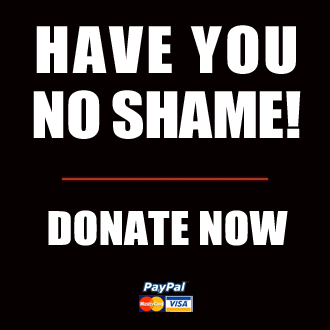


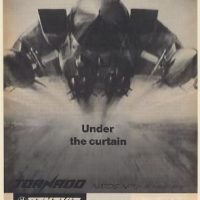


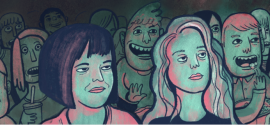

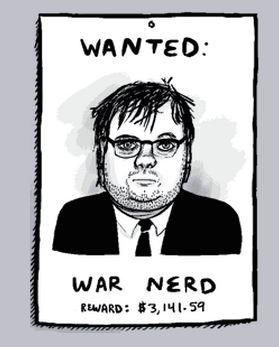

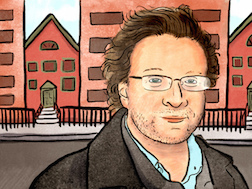
45 Comments
Add your own1. Mish | October 21st, 2009 at 3:28 pm
I like this Matt Harvey guy
2. chugs | October 21st, 2009 at 4:54 pm
1. the factors behind the strength of street drugs are not limited to general economic conditions.
One factor is the cost of goods sold for a drug like heroin. Many of the gangs, especially those in Australia, in fact employ dealers on a hourly wage (and margin and/or a quantity of product for personal use). These other expenses against the direct cost of obtaining the product play, along with supply and demand a big part in how the drug trade works.
From personal experience I remember that heroin profited from the downer/grunge boom of the 1990s but that as young adults became middle age their priorities changed. Instead of being comatose people wanted to live again and hence a extremely cheap alternate came to market at just the right time, that being Meth (ice).
Another big factor was the raise in the abuse of pharmacy supplied over the counter drugs. A good example of this was the ability to extract pure codeine from a common pain pill simply by splitting the tablet in half. (this was tested using a series of chemical agents known as reagents). Those who sought the opiate high no longer had to trawl the streets looking for a bullshit street deal but rather, as long as they looked respectable, could pick up several grams of pure codeine for no more then $15 AUS. The manufacturer has stopped doing this (nurofen) but a new process has been created by the underground that simply involves crushing the tablets, water, and a filter to extract the water soluble codeine.
Sure you can’t inject codeine (unless your absolutely insane and want to die) but you can certainly have a good time with it.
Like was was the growth in the use of other legal alternative. A good example was the ability to buy several KG of poppy seeds for a few dollars and extract large quantities of opiates that were still coating the the seeds, albeit in minute quantities i.e. a few MG or even a few hundred UG. NB: the seeds gestate in the seed pod that secretes the opiates that is in turn used to create heroin. Known as poppy seed tea it is a very quick and cheap way to get high.
Best of all your not just getting one type of opiate, but several types of narcotic opioid alkaloids.
Hence the world saw a collapse in the heroin markets. This also coincided with several political events occurring in the heroin producing nations, notably Afgahstan which at that point was going a notable surge in their never-ending civil war.
Moving on
2. Quality of street drug comes down to the individuals motivation to do something about it. The clever user, using various household chemicals (acetones etc) can in fact, within only some minor loss, remove the cutting agents, and extract pure heroin from the deal. (this works for many other street drugs).
3. It always comes down to who you know. Buying street deals is always a risky proposition. In Australia the mid-to-late 1990s there was a massive heroin boom and yet the street level deals had an element of a lucky dip about them. The people interviewed in this article are hardly in a position to demand quality products.
3. Jay | October 21st, 2009 at 7:32 pm
Most of the heroin in the world comes from Afghanistan. We’ve been shipping tens of thousands of young guys there for eight years. Who could be surprised if some of them came home with a new monkey for their backs or an idea for a lucrative import/export business?
4. adolphhitler | October 21st, 2009 at 7:37 pm
chugs…you say you cant inject codeine…then how is it used? why do all the depicted addicts inject when it is so much healthier to inhale (if this is possible)
5. Padilla | October 21st, 2009 at 11:19 pm
Yawn… Druggies are always a bore, and so is their smug, little druggy world.
Nothing new here.
6. Cobblers | October 21st, 2009 at 11:41 pm
You can’t inject codeine. It causes water on the lungs and you will suffocate.
7. mikey | October 22nd, 2009 at 4:31 am
The effect of injecting codeine is a feeling of being pricked with a million needles and the instant aging of one’s face (about 40 years.) This passes in a minute and everything goes back to normal. We use to try and do this to the unsuspecting for the great show involved. Not a good high, though.
8. Toba | October 22nd, 2009 at 5:34 am
If one has to do 16 bags a day then maybe one should suggest to the dealer(s) to stamp GARBAGE on the bags.
@5 is correct but the real problem is that the idiots whom are dealing, buy cut shit and then in return, because they tend to be a bunch of greedy and stupid assholes, cut the shit some more.They didn’t know what cut it and also don’t know how to cut it.
Unfortunately not many chemistry minors amongst the new breed………..
9. W. Kiernan | October 22nd, 2009 at 6:19 am
In other words, the Times was off by a factor of 10.
Off by a factor of a hundred, you mean. Which is typical of drug war reporting. Say, did you hear about that guy they busted in Atlanta the other day? He was carrying $40-million worth of marijuana, in the back pocket of his jeans.
10. Spade | October 22nd, 2009 at 8:16 am
As many as 16 bags a day… shit, what a loser…
11. numberonewithabullet | October 22nd, 2009 at 8:25 am
Might I suggest Padilla that you’re on the wrong fucking sight. Dick.
12. geo8rge | October 22nd, 2009 at 9:54 am
Cool the old Tompkins Square Park is coming back.
13. Carlos | October 22nd, 2009 at 9:59 am
Numberonewithamullet,
Padilla is right. This article is as fresh as the NYT and Newsday articles it was written to rebut. In the long run, who cares about a bunch of dumbshit addicts with all their bullshit reasons/excuses for doing harder and harder drugs. It’s the same old, same old.
I want more predecitions from Ames about how Western Civilization’s imminent collapse. That’s why I keep coming back. (That and the little-seen War Nerd.)
14. Palmer Eldritch | October 22nd, 2009 at 11:40 am
@Carlos
You might begin to wonder if there’s anything to this “imminent collapse” thing when the first of your pennyloafin’ buddies is found to have turned to hard drugs in the hopes of shutting out the ruminative stress inherent in having nothing to look forward to.
I hope you’ll agree that at least some percentage of y’all business kids who won’t be getting the reward you signed up for might just, after all, turn out to prefer manufactured oblivion over 39 hours a week, $7 an hour, indefinite duration.
15. S | October 22nd, 2009 at 12:38 pm
“shutting out the ruminative stress inherent in having nothing to look forward to”
Whah, whah, whah. Another junkie whiner. I love drugs myself, but I hate junkie scum and, lets face it, if you’re doing smack you’re more likely than not a fucking junkie.
If you can handle your shit and still get on with your life, more power to you, but if you’re debating the merits of injecting codine on a blog, you’re either a junkie or a complete fucking nerd and deserve whatever you get in either case.
16. chugs | October 22nd, 2009 at 1:20 pm
15. S
is that best you can come up with? Seriously some of the posters on exiled are as banal as some of the rejects who inhabit moorewatch.com.
13. Carlos
yep your absolutely right. The article failed to really explain or discuss anything that really breaks into the issue of drugs, stress and bad economic times.
It makes a mockery of the fact that when times are good people still continue to take drugs in every increasing volumes.
that said i think your all bunch of wankers, junkies irrespective of their single minded desire to get high are humans as well who just made a series of mistakes. Normally most junkies have a background and pain that easily explains their desire to hide from reality.
next time you see a junky in a street you should remind yourself that by the grace of chaos go I.
17. Palmer Eldritch | October 22nd, 2009 at 1:51 pm
@S,
Me? I didn’t have any eggs in any of the upset baskets that Carlos keeps his back to. I don’t do smack; I am the wrong kind of egotist.
However, the ruminative stress inherent in having nothing to look forward to is exactly what fuels the demand that Mr. Harvey is talking about here.
Take, for example, an East Coast city such as New York and Philadelphia where the collapse of industrial employment created the aforementioned permanent underclasses.
It’s one thing to be dirt poor, struggling, working your ass off, and dreaming of the compounded miserable hours of your days accumulating into something nice for yourself or your kids.
It’s another thing to be dirt poor without access to a place to work your ass off all day for money, and no plausible way of convincing yourself that you are in line for a more rewarding future.
For a person in the latter category, “getting on with life” is irrational and futile. Getting high is almost clever, and infinitely more rational than the lottery.
Anyway, the point is that the plight of the unincorporated, unencouraged underclass is on the move to new frontiers, and to talk of people “deserving” it is to mark yourself as an atavistic imperial American cunt.
18. Carlos | October 22nd, 2009 at 1:55 pm
@14
I don’t know anyone who wears pennyloafers.
And I guess “ruminative stress” is a euphemism for “completely-self-absorbed-and-lacking-perspective-whiny bitching.” Whatever. If heroin is the only solace for your shit life, then good on ya. You’re a fucking dumbass, but good on ya. Just don’t try to hustle me for change. Better yet, get your ass raped by a Janjaweed in Sudan after he kills your family and burns your possessions, then do heroin, because that would be some real “ruminative stress.” “Life is a bummer” is a pathetic excuse for “ruminative stress.”
@15
The Lost Boys in Sudan walked through the desert and savannah at the mercy of the elements, lions, other predators and merciless humans to reach Egypt and find a way to a better life. If those fuckers aren’t junkies, then no one should be. Fuck the “pain” excuse. That’s weak nuts.
19. Dan | October 22nd, 2009 at 2:29 pm
There are several things in this article which prove it to be fictional. Heroin users don’t inject it “in one shot”. They leave the needle in and draw the compressor in and out of the vein, play with it in and out for some time, maybe up to 10 minutes or so, not just “inject, pull out, wait to nod”.
20. leipzig | October 22nd, 2009 at 3:45 pm
Dan, you’re a cunt.
21. Palmer Eldritch | October 22nd, 2009 at 4:07 pm
@Carlos/18
As we all know, the poor don’t want or lack solace, what they lack are morals. And bootstraps.
22. mrbelding | October 22nd, 2009 at 4:21 pm
Every once in a while a web commenter appears with that rare gift, for which he/she deserves to be singled out. To you Dan, and other commenters that surpass the ignorance of the average Breitbart.com reader, we salute you.
23. Narcoleptic | October 22nd, 2009 at 8:47 pm
I’ve worked with a lot of junkies, and ALL the old junkies agree — street heroin today sucks, at least on the west coast. “Black tar” is, as Matt says, shitty, shitty heroin that destroys your veins. In South Central, they call that stuff “dog food.” Heroin’s still cheaper on the street than Oxy and Lortab, but the guys with money usually prefer the stuff made in a pharmaceutical factory to the crap on the streets. People fucking up their lives by being junkies is a sad pathetic story, but it’s not a new story, and it’s not a news story.
24. vor | October 23rd, 2009 at 10:43 am
Hey Carlos
I’m betting you’d probably prefer being butt-slammed by a well-groomed, 6’2 1/2″, buffed, Navy Seal type rather than a black prison block mama. Am I right ?
25. Butohara | October 23rd, 2009 at 12:06 pm
So, given the increasingly fascistic bent of this country, how long before we see such “undesirables” as painted in the article? Perhaps the Uberbama govt will take the cue from China of past and execute all drug users and drug dealers as drags on society. Looking at the portrayals of these types, there would be little sympathy from the gen pop of Slaveland.
26. Carlos | October 23rd, 2009 at 12:27 pm
Vor,
Huh? How do you get from self-pitying junkies to man-on-man ass love? Is that something you think about constantly–the rough embrace of a hulking man lover? Wow. You should do heroin. If that’s what’s crawling around in your brain, then I won’t blame you for doing so like I do all the other crybaby white guys. I’ll gladly mail you a spoon, a lighter, a syringe, some tubing, and a Playgirl. Just ease up, dude.
27. Chris | October 23rd, 2009 at 5:38 pm
Carlos, we don’t care why you keep coming back.
You egocentric pseudo-intellectual self-hating
pendejo.
Go back to fucking Dan in the ass. I can hear him crying for it from here.
28. Padilla | October 23rd, 2009 at 9:52 pm
I was wrong in my previous post (#5)
Druggies outraged and endlessly whining because others won’t take seriously their tough man bullshit are very comical indeed.
I stand corrected.
29. lol | October 24th, 2009 at 12:39 pm
Sad. I no longer read the political reporting here, but I expected you guys to get shit right at least when it comes to heroin. Black tar is not “highly cut with sticky chemical additives”. That sticky shit is acetylated opium latex, because the makers skip a step in purifying it, to cut costs. There’s more to say on the subject, but fuck it, I won’t do your jobs for you.
30. gary | October 24th, 2009 at 1:32 pm
the commentors seem more interested in insulting each other than discussing the article..too bad
31. tubalkain | October 25th, 2009 at 12:38 am
Chugs, can you elaborate on purifying street dope with acetone pls?
32. chugs | October 25th, 2009 at 1:40 pm
31. tubalkain | October 25th, 2009 at 12:38 am
go to bluelight.ru and search. Even erowid.org might have a bit on it.
The hive and other sites would definitely. usenet probably does as well.
33. Antonio Garcia | October 25th, 2009 at 3:12 pm
I saw the main picture to the article and wondered if that was a dramatization of a heroin addict or if the picture was a real heroin addict
34. Not important | October 25th, 2009 at 7:13 pm
@32-
The hive has been gone for YEARS.
35. Dan | October 27th, 2009 at 1:17 am
Whatever’s written in the comments doesn’t change the fact that this particular article is fictional, or at least partly made up, and by someone who doesn’t have such a great knowledge of heroin use. With all due respect, it’s not the first time in the eXile, it just used to be more obvious.
36. mrbelding | October 27th, 2009 at 3:12 pm
Dan, you’re very stupid. Like so stupid it’s a miracle you can operate a keyboard.
Just because you’ve seen Panic in Needle Park twice and had a chippy for two months in 1998, doesn’t mean you’re the world’s foremost expert on heroin use.
37. Snoop | October 27th, 2009 at 3:42 pm
@29 “That sticky shit is acetylated opium latex…”
That’s like saying: “the powder in East Coast dope is Diacetylmorphine.” Well, yes and no, right? There’s alot of stuff in there as well, mannite and quinine and the like. Thing is, those cuts don’t collapse your veins.
38. Boris B. | October 29th, 2009 at 4:22 am
Who is beautiful girl on top? I love her, I will mary her!
39. aleke | November 4th, 2009 at 11:07 am
@Dan
Go away, Glenn Beck
40. T-bone | June 29th, 2010 at 11:14 am
Looks like the CIA are back doing their old tricks again.Flooding the streets with Afgan smack so the can fund their covert operations and keep it all hidden away from congress!
41. LibertineNY | February 9th, 2012 at 8:30 pm
I personally found this article rather interesting. It’s true that the media hypes up fictional or minute drug epidemics for profit but in the case of opiates personal observations these past few years have led me to believe that there is, indeed, a spike in use. Over the past few years, a good chunk of the people I knew (I’m 21 just to give a sense of the age group which I am referring to) have become addicted to prescription opiates. I blame the pharm industry for normalizing these drugs and labeling them as “medications” lulling people into a false sense of security when taking them. What’s been happening lately is a lot of them have been finding painkillers to be too pricey of an addction to entertain (roxicodone here goes for 16+ and opana er 40 mg goes for over 20) and have been switching over to heroin for practical purposes. I think there is most certainly a spike in use but that spike stems from doctors over prescribing pain medications and a uninformed population thinking they are safer to use than they actually are.
42. killer | February 12th, 2012 at 11:54 am
poison all the drugs !
kill all suspected drug users and any of there family members.
so easy quick and simple .reduces the shit population fast.
43. ccurzpi | January 1st, 2015 at 3:46 pm
HELLO,
I AM IN MY 60’S AND WHEN THEY HAD 2 DOLLAR BAGS, [ 1968-69] JUNK WAS POTENT AND ADDICTING. JUNK DOES A LOT FOR ONE AND IT’S AL BAD. HEROIN ERMOVE YOUR ANXIETY, AND BRING YOU TO PLACES YOU MAY NEVER BE ABLE TO ERTURN. I LOST MANY FIRENDS THRU OD’S, DOING LONG BIDS , ETC. IN THOSE DAYS , SOME DEALERS WOULD CUT THE DRUGS WITH QUININE, MAKE YOU SCRATCH All DCAY. I HEARD SAME ARGUMENTS ABOUT QUALITY OF JUNK, GOOD SOMEDAYS BAD NEXT. G;LAD TO BE OUT OF THAT LIFE. THOSE ADYS NO METHADONE/ SUBOXONE GET BUSTED AND KICK IN TOMBS COLD. SELF HELP GROJPS ARE BETTER, ISTEAD OF DEAD END LIFE.
44. Bob | June 14th, 2015 at 12:42 pm
“killer”- I may be a junky, but at least I know you should have used “their” instead of “there” you moron. Rather than killing all junkies, let’s kill all the unintelligent mouth-breathers that can’t get simple grade school grammar right.
45. Mike D | June 14th, 2017 at 8:29 pm
Sure, hindsight is 20/20, but it’s fair to say that Matt’s strength is not investigative journalism. He goes great lengths to dismiss and refute the alleged uptick in heroin use, unfortunately in his efforts to do so he completely ignores widely available facts and data. As he turns his argument into a trend piece, focused on selling the idea that there is no epidemic and it’s a media created illusion and that the junkies today are the same people who were junkies five years ago, Matt lazily neglects to dive into the one catalyst among all of the other controls in this experiment: opioids and the rise of prescription pain killers. These pills have led to the rise of newly inducted members of the heroin addicted family and they’re most certainly not the junkies of five years ago. Sure it’s easy for me to point this out in 2017 as overdose rates are at historic levels, but the data was there in 2009 and, since he wanted to write a story in which he makes an argument, Matt should be expected to at least do some research and learn more about the subject.
Leave a Comment
(Open to all. Comments can and will be censored at whim and without warning.)
Subscribe to the comments via RSS Feed